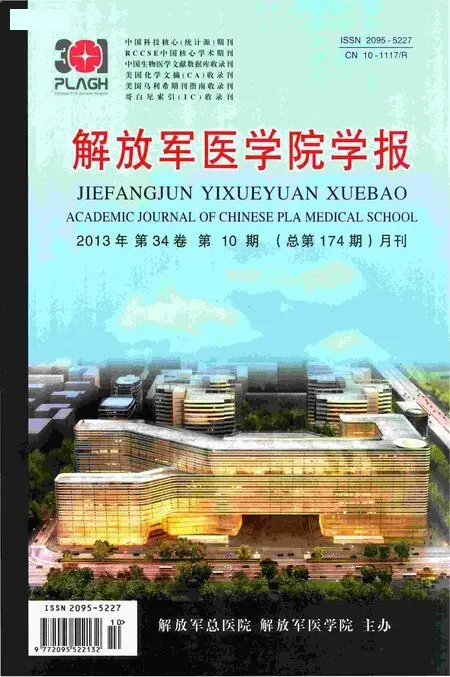转录抑制因子CUTL1肿瘤治疗的新靶点
李婷婷 综述 吴本俨 审校
解放军总医院 南楼消化内科,北京 100853
转录因子CUTL1作为转录激活因子和转录抑制因子参与许多细胞基因的转录调节,从而调节细胞的生长、分化和发育[1]。1999年,Zeng等[2]进行杂合性缺失研究,认为CUTL1可能作为肿瘤抑制基因的候选基因。2002年,Goulet等[3]的体外实验表明,CUTL1的高表达可促进乳腺癌的发生。细胞周期蛋白A-cdk1和蛋白激酶C在多个位点对CUTL1进行磷酸化的调节,抑制其DNA结合活性[4]。CUTL1还是TGFβ信号转导通路的一个靶标,介导TGFβ的促迁移活性并在促进细胞运动和肿瘤细胞侵袭性生长方面发挥重要作用[5],下调CUTL1的表达有望成为肿瘤治疗的新靶点。CUTL1(Cut like1),又称CutX1或CCAAT置换蛋白(cux/CDP),属于在进化上高度保守的同源结构域转录因子CDP家族[1]。荧光原位杂交证实CUTL1定位于7q22,参与细胞的生长、分化和发育,该区域在多种肿瘤中表达缺失[1,6]。
1 CUTL1的生物学功能
1.1 CUTL1与肿瘤发生 2011年,Hanahan和Weinberg[7]在Cell上发表文章指出肿瘤细胞有十个重要特点: 自给自足的生长信号,抗生长信号的不敏感,回避凋亡,潜力无限的复制能力,持续的血管生成,组织浸润和转移避免免疫摧毁,促进肿瘤的炎症,细胞能量异常以及基因组不稳定和突变。研究表明CUTL1可提高肿瘤细胞的肿瘤特性,如持续的血管生成,抗凋亡能力等。Vadnais等[8]研究表明转录因子CUTL1不仅可以调控细胞周期进展和DNA修复,还有利于维持基因组的完整性。Siam等[9]在小鼠模型中发现过表达或敲除其靶基因Lats1均可导致肿瘤发生。
1.2 CUTL1与肿瘤的侵袭转移 肿瘤细胞的运动、迁移和侵袭以及抗凋亡能力与CUTL1紧密相关,CUTL1作为原癌基因促进肿瘤细胞的侵袭和转移。Michl等指出CUTL1的活性和多种癌细胞系的迁徙、转移相关,并受TGF-β调控,从而激活细胞运动、迁徙和细胞外基质中的有关基因[5,10]。Aleksic等[11]研究发现CUTL1可促进肿瘤细胞迁移,指出CUTL1可稳定Src并通过上调Csk减少蛋白酶介导的蛋白降解。Kedinger等[12]探讨了促进癌细胞运动能力的另一可能机制,发现CUTL1的同种型p110 CUTL1在CUTL1引起的癌细胞迁移运动中发挥作用,同时发现p110 CUTL1可以刺激细胞播散和黏附。研究显示,多个CUTL1靶基因的表达与肿瘤细胞浸润周围组织有关[13]。用RNAi的方法下调CUTL1的表达能显著削弱肿瘤细胞在实验性转移模型中的肺克隆形成率,提示CUTL1的转录活性在肿瘤侵袭转移中发挥重要作用,并可能增加肿瘤的去分化能力[8]。
2 CUTL1的作用机制
2.1 在转录调控中发挥作用 Cut重复子和Cut同源结构域的不同组合可产生不同的DNA结合活性,其活性与细胞增殖和细胞周期进展有关,在增殖细胞中增加,终末分化时下降,并能调节参与终末分化的基因。实验证实用Cux-1同系物进行敲除实验后的小鼠,其肺上皮细胞生长发育迟缓、毛囊缺陷、雄性个体生殖能力下降、T细胞和B细胞功能缺陷。与此相反,转Cux 1基因小鼠则表现为器官肥大和多器官增生[14]。CDP/Cut功能可集中于转录后修饰如磷酸化和乙酰基化。蛋白酶L通过加工处理转录因子CDP/Cux产生较短的异构体,从而参与细胞周期的调控[8]。
2.2 为TGFβ信号转导通路的一个靶标 CUTL1可促进细胞的运动和侵袭能力。已知TGFβ为调节肿瘤细胞迁移、侵袭和上皮间质转变的主要因子。通过研究肿瘤相关信号途径对CUTL1的作用,显示CUTL1为TGFβ的一个靶标,介导TGFβ的促迁移活性[15]。TGFβ可促进CUTL1的表达[16-17]。作为重要的转录因子,CUTL1参与调控多个生理病理过程。除了PI3K/Akt和TGFβ两个重要的信号转导通路,Liu等认为CUTL1在其他信号通路如WNT/β-catenin和JAK/STAT3中也发挥作用,WNT5A是WNT基因家族成员分泌的信号蛋白,是CUTL1的下游分子,同时,CDP和Sox2可以相互作用,Sox2是重要的转录因子,在细胞的自我更新、多潜能分化以及未分化胚胎干细胞发育过程中发挥重要作用,参与JAK/STAT3信号通路; CUTL1在WNT/β-catenin和JAK/STAT3信号通路中发挥作用,同时分别通过TNF、Src和shh(Sonic hedgehog)参与TNF、MAPK/ERK以及Hedgehog信号通路,据此推断,CUTL1可以参与和整合多个信号通路; 转录因子CUTL1在肿瘤发生发展中的作用目前存在争议,部分研究者认为CUTL1可以通过降低表达抑制肿瘤发生,然而,更多的研究者认为CUTL1过表达可以促进肿瘤进展[18-20]。
现有数据显示,CUTL1在建立肿瘤细胞偏爱运动和侵袭行为的模式中起关键作用[21]。由TGFβ诱导的CUTL1的表达对TGFβ促进细胞运动是必要的,但其精确机制还有待进一步研究,CUTL1可能是晚期肿瘤中TGFβ肿瘤促进效应的一个关键介导者[8]。研究发现CUTL1在胃癌耐药细胞和组织中表达下调[22],通过促进细胞多极分裂导致染色体不稳定[23],其靶标谷氨酸受体 GRIA3在胰腺癌进展中发挥一定作用[24]。迄今为止,仅有一篇文献报道CUTL1在翻译水平的调控作用。Xu等[25]通过荧光报告基因表达等研究发现,肝脏特异性的microRNA miR122,在小鼠肝胚胎发育中表达,可对CUTL1的翻译起抑制作用,在小鼠胎肝和人肝的癌细胞中,四类肝细胞高表达的转录因子(包括HNF1α,HNF3β,HNF4α以及C/EBPα)共同调控miR122的表达,同时,通过过表达和基因敲除等方式,在肝脏发育的转录后水平,CUTL1的表达逐渐被静止。
3 结语
转录因子CUTL1在肿瘤发生发展中起重要作用,有望成为阻断肿瘤进展的新靶点和肿瘤化疗的新星。检测其在肿瘤发生发展过程中的表达,与其他肿瘤相关转录因子的相互作用,及其靶基因和已知肿瘤相关基因的关系网络是未来研究的主要方向。新的靶向研究技术如适体-siRNA结合体将有助于进一步探讨转录因子CUTL1在肿瘤发生发展及肿瘤治疗中的作用。
1 Harada R, Bérubé G, Tamplin OJ, et al. DNA-binding specificity of the cut repeats from the human cut-like protein[J]. Mol Cell Biol, 1995, 15(1): 129-140.
2 Zeng WR, Watson P, Lin J, et al. Refined mapping of the region of loss of heterozygosity on the long arm of chromosome 7 in human breast Cancer defines the location of a second tumor suppressor gene at 7q22 in the region of the CUTL1 gene[J]. Oncogene, 1999, 18(11): 2015-2021.
3 Goulet B, Watson P, Poirier M, et al. Characterization of a tissuespecific CDP/Cux isoform, p75, activated in breast tumor cells[J].Cancer Res, 2002, 62(22): 6625-6633.
4 Goulet B, Baruch A, Moon NS, et al. A cathepsin L isoform that is devoid of a signal peptide localizes to the nucleus in S phase and processes the CDP/Cux transcription factor[J]. Mol Cell, 2004, 14(2): 207-219.
5 Michl P, Ramjaun AR, Pardo OE, et al. CUTL1 is a target of TGF(beta) signaling that enhances cancer cell motility and invasiveness[J]. Cancer Cell, 2005, 7(6):521-532.
6 Nepveu A. Role of the multifunctional CDP/Cut/Cux homeodomain transcription factor in regulating differentiation, cell growth and development[J]. Gene, 2001, 270(1-2): 1-15.
7 Hanahan D, Weinberg RA. Hallmarks of Cancer: the next Generation[J]. Cell, 2011, 144(5): 646-674.
8 Vadnais C, Davoudi S, Afshin M, et al. CUX1 transcription factor is required for optimal ATM/ATR-mediated responses to DNA damage[J]. Nucleic Acids Res, 2012, 40(10): 4483-4495.
9 Siam R, Harada R, Cadieux C, et al. Transcriptional activation of the Lats1 tumor suppressor gene in tumors of CUX1 transgenic mice[J].Mol Cancer, 2009, 8:60.
10 Michl P, Downward J. CUTL1: a key mediator of TGFbeta-induced tumor invasion[J]. Cell Cycle, 2006, 5(2):132-134.
11 Aleksic T, Bechtel M, Krndija D, et al. CUTL1 promotes tumor cell migration by decreasing proteasome-mediated Src degradation[J].Oncogene, 2007, 26(40): 5939-5949.
12 Kedinger V, Sansregret L, Harada R, et al. p110 CUX1 homeodomain protein stimulates cell migration and invasion in part through a regulatory cascade culminating in the repression of e-cadherin and occludin[J]. J Biol Chem, 2009, 284(40):27701-27711.
13 Joyce JA, Baruch A, Chehade K, et al. Cathepsin cysteine proteases are effectors of invasive growth and angiogenesis during multistage tumorigenesis[J]. Cancer Cell, 2004, 5(5): 443-453.
14 Luong MX, van der Meijden CM, Xing D, et al. Genetic ablation of the CDP/Cux protein C terminus results in hair cycle defects and reduced male fertility[J]. Mol Cell Biol, 2002, 22(5): 1424-1437.
15 Sun J, Deng WM. Notch-dependent downregulation of the homeodomain gene cut is required for the mitotic cycle/endocycle Switch and cell differentiation in Drosophila follicle cells[J].Development, 2005, 132(19): 4299-4308.
16 Martin-Soudant N, Drachman JG, Kaushansky K, et al. CDP/cut DNA binding activity is down-modulated in granulocytes,macrophages and erythrocytes but remains elevated in differentiating megakaryocytes[J]. Leukemia, 2000, 14(5): 863-873.
17 Sansregret L, Nepveu A. The multiple roles of CUX1: insights from mouse models and cell-based assays[J]. Gene, 2008, 412(1-2):84-94.
18 Liu KC, Lin BS, Zhao M, et al. Cutl1: a potential target for Cancer therapy[J]. Cell Signal, 2013, 25(1): 349-354.
19 Engelen E, Akinci U, Bryne JC, et al. Sox2 cooperates with Chd7 to regulate genes that are mutated in human syndromes[J]. Nat Genet, 2011, 43(6): 607-611.
20 Ripka S, König A, Buchholz M, et al. WNT5A--target of CUTL1 and potent modulator of tumor cell migration and invasion in pancreatic Cancer[J]. Carcinogenesis, 2007, 28(6): 1178-1187.
21 Hulea L, Nepveu A. CUX1 transcription factors: from biochemical activities and cell-based assays to mouse models and human diseases[J]. Gene, 2012, 497(1): 18-26.
22 Li T, Wang H, Sun Y, et al. Transcription factor CUTL1 is a negative regulator of drug resistance in gastric Cancer[J]. J Biol Chem,2013, 288(6): 4135-4147.
23 Sansregret L, Vadnais C, Livingstone J, et al. Cut homeobox 1 causes chromosomal instability by promoting bipolar division after cytokinesis failure[J]. Proc Natl Acad Sci U S A, 2011, 108(5):1949-1954.
24 Ripka S, Riedel J, Neesse A, et al. Glutamate receptor GRIA3--target of CUX1 and mediator of tumor progression in pancreatic Cancer[J]. Neoplasia, 2010, 12(8): 659-667.
25 Xu H, He JH, Xiao ZD, et al. Liver-enriched transcription factors regulate microRNA-122 that targets CUTL1 during liver development[J]. Hepatology, 2010, 52(4): 1431-1442.

